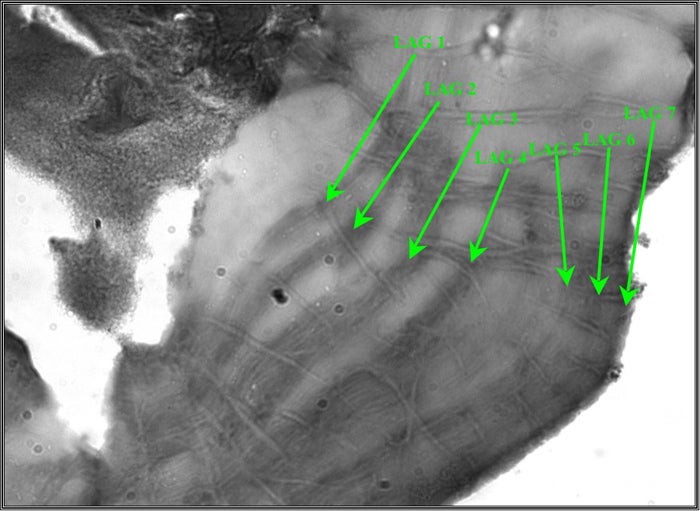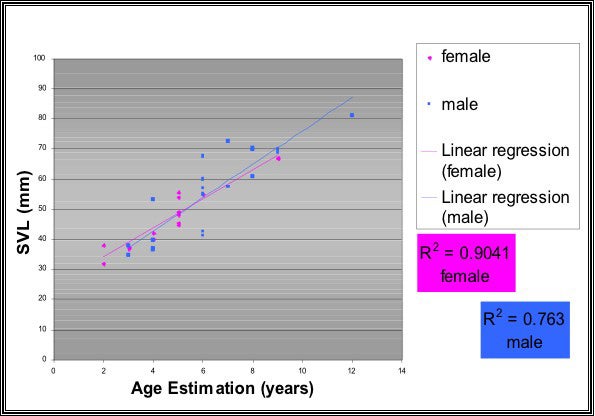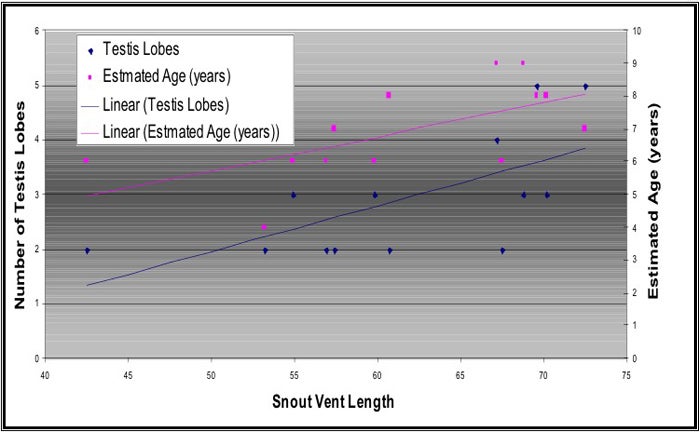.
|
|
|
|
|
|
|
|
|
|
|
|
|
|
Abstract:
...The genus Desmognathus has received considerable attention from the herpetological research community in recent years because natural history and taxonomic studies have led to the conclusion that disparities in morphology between populations of salamanders across the southern Appalachians need to be addressed. Age was estimated via skeletochronology among five populations (n = 10) of D. quadramaculatus in Virginia, Tennessee, North Carolina and West Virginia. Both adult and juvenile salamanders were collected. Salamanders were dissected to determine sex and reproductive status. Skeletochronology was used to estimate the age of each animal by examining cross-sections of the femoral diaphysis to count the lines of arrested growth (LAGs) which theoretically demarcate over-wintering periods. LAGs were compared to the size of each salamander across four states in the southern Appalachians, both for the entire sample and for each sex individually.
|
|
|
|
|
|
|
|
|
|
|
|
|
| . |
|
|
|
|
|
|
|
|
|
|
|
|
|
|
|
|
|
Fig. 1 Cross section of femoral diaphysis at 400x magnification showing LAGs.
|
|
|
| |
|
|
|
|
|
|
|
|
Introduction:
... Differences in adult body size between populations of D. quadramaculatus have been observed throughout the Southern Appalachians (Whooten, 2001). Differences in body size between populations can occur for numerous reasons, including biotic and abiotic factors. Elevation, rainfall and time and size at metamorphosis have all been considered for differences in adult body size.
Time and size at metamorphosis are thought to be the two factors which contribute most to maximum adult size (Beachy, 1995; Beachy and Bruce, 1993; Bruce 1996; Titus and Larson, 1996). Controlling the timing of metamorphosis allows individuals to maximize the probability of growth to a larger size and increasing their chance of survival against sympatric salamanders (Beachy, 1995). The size that is achieved at metamorphosis is controlled by the timing, as well as the individual hatching size and larval growth, which is ultimately dependent upon the resources available (Bruce, 1996; Camp et al, 2000).
... Camp, et al (2000) observed that salamanders inhabiting wetter climates have an increased size at first reproduction, indicating a larger size at metamorphosis, concluding that adult size may be related to rainfall.
... Size at metamorphosis has been found to be indicative of the size at maturation (Beachy, 1995; Beachy and Bruce, 1993; Bruce 1996; Titus and Larson, 1996). After maturation, further growth can occur in males but tends to be very slow, while no further growth tends to occur in females (Beachy and Bruce, 1993).
... The objectives of this study are to determine the correlation between age of D. quadramaculatus collected from 5 populations and snout-vent lengths, and determine if there are any differences in age vs. body length between the sexes.
|
|
|
|
|
|
|
|
|
|
|
|
|
. |
|
|
|
|
|
|
|
|
|
|
| |
|
|
|
|
|
|
|
|
Fig. 2 Body size and age estimation for all salamanders. |
|
|
| |
|
|
|
|
|
|
|
|
Methods:
... D. quadramaculatus were collected in 5 series of 10 animals from West Virginia, Virginia, Tennessee, and North Carolina. Two series were collected from two streams in West Virginia (n=20), and one series was collected from each of the other three locations. Salamanders were collected by hand and with dip nets, placed in Ziploc© bags, and transported in a refrigerated cooler. In the lab, the salamanders were euthanized in 10% chlorotone (Fisher).
The skeletochronology method was modified from Castanet et al., 1996 and Trenham et al., 2000. One femur was removed from each of the salamanders used in this study after approximately 1 month of storage in ethanol. The bones were then temporarily stored in labeled micro-centrifuge tubes in distilled water at 4 °C. The femurs were decalcified for 1 (sub-adults) to 2 (adults) hours in 3% nitric acid. The bones were then washed in running tap water overnight. The femurs were mounted in frozen tissue embedding medium and 14µm sections were made from the diaphysis of each bone using a cryostat (Leica). Samples were then rinsed for 30 seconds each in 75% ethanol and tap water, stained for 1 hour in Harris Hematoxylin (Fisher), and rinsed 30 seconds in tap water a second time. The samples were mounted using Permount mounting medium (Fisher).
... The lines of arrested growth (LAGs) were counted (Fig. 1) under 400x magnification to determine the age of each salamander. This data was then compared to snout-vent length (SVL) and sex of each animal. Sex was determined by dissection to assess the egg volume and number of eggs in mature females and the number of testis lobes in mature males.
... Linear regression analyses were used to determine if there is a significant correlation between age, size, and reproductive status in the populations assessed. |
|
|
|
|
|
|
|
|
|
|
|
|
| . |
|
|
|
|
|
|
|
|
|
|
|
|
|
|
|
|
| |
|
|
Fig. 3 Body size and age estimation for all salamanders separated by sex. |
|
|
| |
|
|
|
|
|
| |
|
|
Results:
... Only 37 of the original 50 samples were able to be carried through preparation to successful age estimation following the described method. Significant correlation (R2=0.8) was found between age and body size for the entire sample (Fig. 2), with a stronger correlation among females (R2=0.9) than males (R2=0.8) (Fig. 3). Of the 22 males observed in this study, only 15 were successfully scored for age. No significant correlation was observed between number of testis lobes in males and estimated age (R2=0.214) or between number of testis lobes and SVL(R2=0.417) (Fig. 4). Only two female salamanders were observed to be sexually mature, therefore, no analysis was completed to correlate their age and reproductive status. |
|
|
| |
|
|
|
|
|
|
|
|
|
| |
| |
|
|
|
|
|
|
|
|
|
| |
|
|
|
|
|
| |
|
|
Fig. 4 Number of testis lobes compared with snout-vent length and estimated age |
|
|
| |
|
|
|
|
|
|
|
|
|
| |
|
|
|
|
|
| |
|
|
Discussion:
... Correlations between age and body size were estimated using a linear regression, while the actual relationship has been reported to follow the Logistic Model:
... L=a/ (1+ ec-bt)
where: L is the SVL(mm) at
... t time (year)
... a is the asymptotic size
... c is the constant determined by setting 0 to t
... b is the instantaneous growth rate
(Ento & Matsui, 2002).
... Age estimation using this method proved somewhat difficult in terms of the percentage of original samples successfully aged (approx. 75%), suggesting further optimization of the technique is necessary. Possible areas of improvement include: using paraffin-embedded sections instead of frozen sections for improved preservation of morphology, further experience in excision of femurs from animals to minimize post-mortem disruption. However, the well-correlated age estimates and body sizes suggest a decent level of precision in the overall process.
... Low sample size when comparing reproductive status in this study most likely accounted for the low correlations (Fig. 4). Random field collections including males, females and juvenile salamanders at each field site contributed to the low sample size in any one category. |
|
|
| |
|
|
|
|
|
|
|
|
|
|
| |
|
|
|
|
|
|
|
|
|
| |
|
|
References
Beachy, CK. 1995. Effects of larval growth history on metamorphosis in a stream-dwelling salamander (Desmognathus ochrophaeus). Journal of Herpetology 29(3): 375-382
Beachy, Ck and RC Bruce.2003. Life History of a small form of the plethodontid salamander Desmognathus quadramaculatus. Amphibia-Reptilia 24:13-26
Camp, CD, JL Marshall, RA Austin Jr. 2000. The evolution of adult body size in black-bellied salamanders (Desmognathus quadramaculatus complex). Canadian Journal of Zoology. 78: 1712-1722
Castanet, J., H. Francillon-Vieillot, and R. Bruce. 1996. Age Estimation in Desmognathine Salamanders Assessed By Skeletochronology. Herpetologica, 52(2):160-171.
Ento, K. and M. Matsui. 2002. Estimation of Age Structure by Skeletochronology of a Population of Hynobius nebulosus in a Breeding Season (Amphibia, Urodela). Zoological Science, 19:241-247.
Titus, TA, and A. Larson. 1996. Molecular phylogenetics of Desmognathine salamanders (Caudata: Plethodontidae): a reevaluation of evolution in ecology, life history, and morphology. Systematic Biology 45(4): 451-472
Trenham, P., B. Shaffer, W. Koenig, and M. Stromberg. 2000. Life History and Demographic Variation in the California Tiger Salamander (Ambystoma californiense). Copeia, 2:365-377.
Whooten, J. (2001) Distribution, morphometrics and tooth morphology of the genus Desmognathus in West Virginia. Master’s Thesis, Marshall University, Huntington, WV
|
|
|
|
Acknowledgments
David Neff for several hours of consultation with confocal, transmitted light, and electron microscopy techniques.
Dr. Michael Norton for providing the accessible, and well equipped Marshall Imaging Core Facility including specifically, the use of transmitted light microscope, confocal microscope, and scanning electron microscope, supported in part by NSF-EPSCoR grant #0132740.
|
|
|
| |
|
|
| |
|
|
| |
|
|
|
|
|
|
|
|
|
| |
|
|

Confocal instrumentation page
Back to Example Projects |
| |
|




